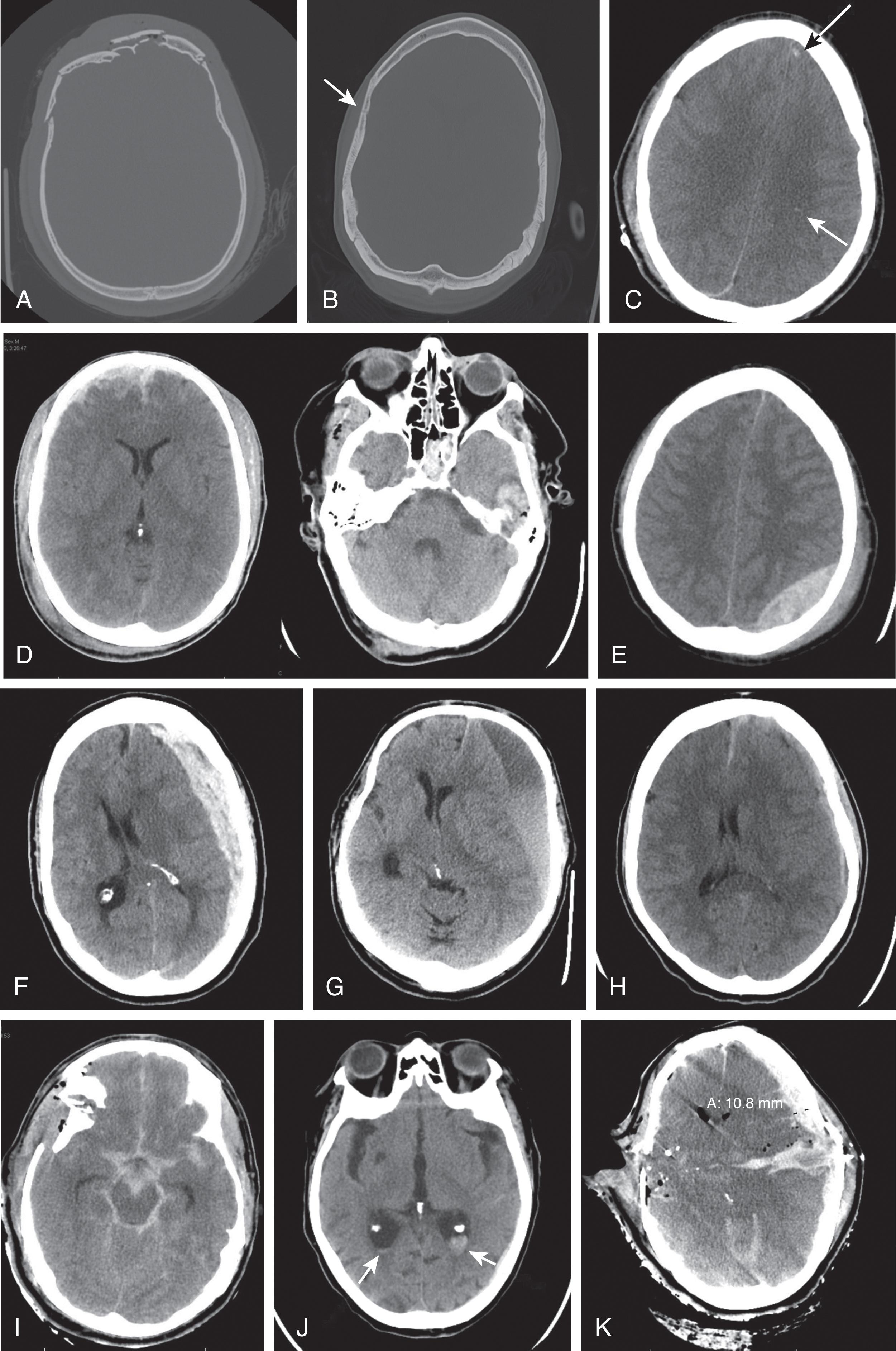Physical Address
304 North Cardinal St.
Dorchester Center, MA 02124
Traumatic brain injury (TBI) is defined as an injury to the brain caused by an external force to the head that results in disruption of the normal function of the brain. It can be a direct or indirect injury due to penetrating or blunt forces. Mild injuries can result in only a headache or brief change in mental state, while severe injuries can result in death and lifelong disability. Head trauma can lead to brain injury through primary or secondary mechanisms. The primary injury is a result of the direct mechanical damage that occurs at the time of trauma. Secondary injury occurs in the following days and weeks due to a variety of pathologic processes. Most hospital interventions are aimed at minimizing secondary damage to the brain. This chapter will review the epidemiology and pathophysiology of TBI and review the diagnosis and early care for head injured patients.
TBI contributes to a substantial number of deaths and cases of permanent disability each year. The societal costs are huge, with direct costs of hospitalizations and rehabilitative care as well as indirect costs such as lost income, lost productivity, and need for long-term care from family and community members.
According to the Centers for Disease Control and Prevention (CDC), nearly 3 million TBI-related hospital visits and deaths occurred in the United States in 2014. The true incidence is unknown, as a large number of mild traumatic brain injuries go unreported. Although nearly 90% of these patients are treated and released from the emergency department, nearly 10% are hospitalized and 50,000 die. It is a contributing factor in one third of trauma related deaths in the United States and costs an estimated $70 billion per year.
Data from the CDC show approximately 2% of the population suffer disability as a result of TBI, and deaths from head injuries account for one third of all traumatic deaths. Significant public health initiatives have helped reduce TBI by attempting to prevent falls, improving the culture of sports to avoid head injury and concussion, and improving motor vehicle safety.
The rates and causes of injury vary significantly by age. Males are much more likely to sustain a TBI, with 78.8% of all reported TBIs in males and 21.2% in females. However, studies have shown female athletes to have higher reported rates of concussion, or mild TBI, than males in comparable sports. Motor vehicle accidents are the most common cause of TBI that leads to hospitalization, representing 50% to 70% of all TBIs. The most common causes of head trauma in children and youths are falls, motor vehicle accidents, sports-related injuries, and being hit on the head or colliding with an obstacle. Falls are most common in the elderly and are the leading cause of death in those over the age of 75. As a result of the aging population, we are seeing a shift toward head injuries in the geriatric patients ( Fig. 1 ). In 2014, the CDC reported the rates of TBI-related hospitalizations per 100,000 population were highest among older adults aged > 74 years.

Head injuries include skull fractures, diffuse brain injuries, and focal brain injuries. They can be blunt or penetrating, and the pathophysiology, severity, urgency, treatment, and outcomes are different in each group.
Skull fractures are common but do not, by themselves, cause neurological injury ( Fig. 2A, B ). The significance of a skull fracture is that it identifies patients with a higher probability of having or developing an intracranial hematoma or diffuse brain injury. Fractures can be further classified as being of the cranial vault or skull base. They can be linear or stellate, depressed or nondepressed, and open or closed. Open skull fractures have a direct communication between the outside world and the intracranial space. Surgical intervention should be performed for open depressed skull fractures to explore the wound and evaluate the dura to determine if it is intact and prevent a cerebrospinal fluid (CSF) leak. Basilar or skull base fractures (7%–15% of all skull fractures) require special attention as they may develop CSF leak with otorrhea or rhinorrhea. Intracranial air is often present on imaging studies. Hemotympanum, Battle’s sign (ecchymosis in the mastoid region), or raccoon eyes (periorbital ecchymosis) can often be seen on exam. Beware passing a nasogastric tube on these patients as it can go directly into the brain. Although basilar skull fractures place the central nervous system in contact with bacteria from the nose and throat and may be associated with CSF leakage, studies suggest there is no benefit to antibiotic prophylaxis for skull base fractures, even in the event of CSF leak.

Diffuse brain injuries are produced by rapid acceleration or deceleration of the brain that can cause depolarization of cells, impairment of axoplasmic flow, or tearing of axons or vessels. Concussion is the mildest form of this. It represents a physiologic change in the brain, often without changes that can be detected on conventional imaging studies. Diffuse axonal injury (DAI) occurs when axons are sheared due to the movement and rotation of the brain within the skull ( Fig. 2C ). It often causes coma and can be difficult to see on CT imaging but is more obvious on MRI due to the edema that accompanies the injury. Surgical intervention is not warranted for DAI, but edema may require treatment. Numerous studies have attempted to grade DAI and predict outcomes based on the locations but have not been definitive.
Additional injuries can be present at a cellular level through many complex processes. Hypoxia, abnormalities in neurotransmitter release, trauma-induced apoptosis, and other biochemical and cellular processes can also occur and can cause temporary or permanent changes in brain functioning.
Focal injuries include contusions and hematomas and may cause mass effect requiring surgery ( Fig. 2D ). They can increase in size and require monitoring. Cerebral contusions are bruises to the brain that can occur at the area of impact (coup contusions) or remote from the impact due to the brain moving in the cushion of CSF (contrecoup contusions). They frequently occur at areas where the brain contacts bony prominences of the skull, such as the frontal and temporal lobes. They can cause neurological deficits if they involve eloquent cortex, and mass effect from the contusion itself or from the pericontusional edema can cause herniation and compression of the brain, which may result in secondary injury or delayed neurological deterioration. Although the terms “cerebral contusions” and “parenchymal hematomas” are often used interchangeably, parenchymal hematomas represent solid blood clots within the brain itself, while in contusions the extravasated blood mixes freely with the brain tissue.
Epidural hematomas are blood clots that occur in the potential space between the skull and the dura ( Fig. 2E ). They can occur from bone bleeding due to fractures of the skull or tears in venous sinuses (often under low pressure),or from tears in a dural artery such as the middle meningeal artery. A skull fracture is often present but not required for development of epidural hematomas. Neurological deficits are due to brain compression, and secondary brain injury will occur rapidly if the hematoma is not evacuated quickly, but with rapid surgical evacuation it can have an excellent prognosis. The “classic” presentation of a loss of consciousness due to the initial concussive effect of the blow to the head followed by a lucid period as the clot grows to a size large enough to produce compression of the brain is actually quite rare.
Subdural hematomas are more common than epidural hematomas and can be life-threatening. They are blood clots that occur in the space between the dura and the cerebral cortex and often occur from rupture of bridging veins between the cortex and dura or with lacerations of the brain or cortical arteries ( Fig. 2F-H ). The incidence is high in the elderly with falls, especially with patients on antiplatelet or anticoagulation medications. Surgical evacuation is recommended if there is mass effect, and the prognosis is worse than with epidural hematomas but is improved with early surgical evacuation. These bleeds can be subclinical initially but can become more symptomatic as they liquefy and form membranes that have a high propensity for rebleeding. Mixed density on imaging can signify blood of different age.
Subarachnoid hemorrhage is the most common posttraumatic hemorrhage and is caused by bleeding from small vessels on the cortical surface that mixes with spinal fluid beneath the arachnoid membrane ( Fig. 2I ). Although this represents a significant injury to the brain, it rarely requires specific intervention.
Intraventricular hemorrhage is blood within the ventricles ( Fig. 2J ). Small amounts are not uncommon in severe TBI and do not require special treatment but are a marker for the severity of the injury. With larger amounts or in specific locations, these patients can be at risk of developing acute or chronic posttraumatic hydrocephalus.
Penetrating brain injuries are less common than closed head injuries but can carry a worse prognosis. They can be caused by low-velocity objects, such as skull fragments or foreign bodies such as metal or organic matter, and by high-velocity objects, such as gunshot wounds ( Fig. 2K ). Primary injury to the brain depends on the kinetic energy of the object, and thus larger-caliber bullets with higher velocity will be more likely to cause death or severe injury. Objects protruding from the skull should not be removed until they can be carefully evaluated. Neuroimaging is critical in decision making, and it is not uncommon for penetrating brain injuries to be treated nonsurgically.
Become a Clinical Tree membership for Full access and enjoy Unlimited articles
If you are a member. Log in here